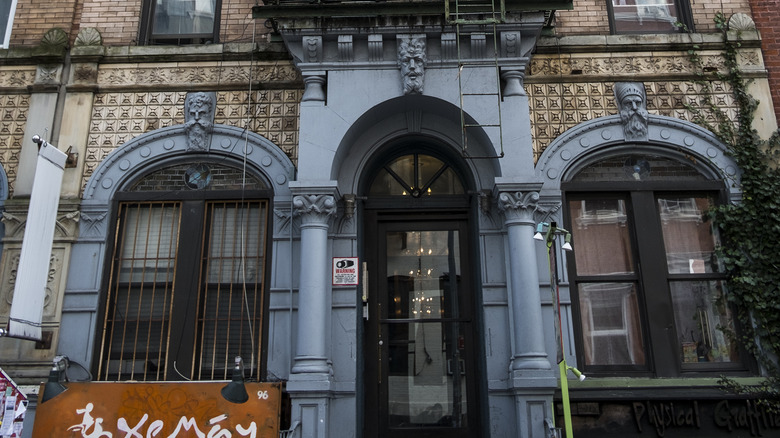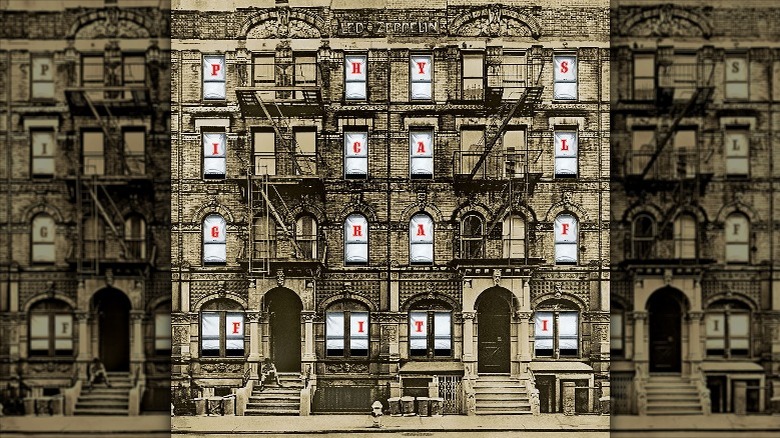All Of The Pop Culture References On Led Zeppelin's Physical Graffiti Cover
We may receive a commission on purchases made from links.
The mid-1960s through the late 1970s were the golden age for rock 'n' roll album covers, including Andy Warhol's iconic 1967 cover for The Velvet Underground and Nico's debut featuring a peelable banana. The Beatles' 1967 "Sgt. Pepper's Lonely Hearts Club Band," which featured images of various culturally influential people, from Edgar Allan Poe to comedian Lenny Bruce, was another major milestone for album art. In 1975, Led Zeppelin followed suit with the cover for their double album "Physical Graffiti."
No slouches in the album cover artwork department, the band had already released several seminal album covers (that's not even mentioning the iconic music inside them), including the band's first album that featured the Hindenburg disaster, their mysterious cover for their 1971 untitled fourth album (commonly referred to as Led Zeppelin IV) that included an oil painting hanging on a decaying wall of an elderly man overburdened by a bundle of tree limbs on his back. Then there was the even more mysterious "Houses of the Holy" from 1973, with its blond children crawling across The Giant's Causeway rocks in Northern Ireland.
The album cover features two buildings in New York City's East Village
Led Zeppelin's "Physical Graffiti" had a very different feel than the band's previous covers and, like "Sgt. Pepper's," featured various culturally significant people. Peter Corriston, who designed the album's cover alongside Mike Doud, spent weeks wandering around New York City trying to find the perfect building for the cover of "Physical Graffiti." He needed one that was symmetrical with interesting details, had nothing blocking it, and would fit well within the square composition necessitated by the cover's shape, according to The New York Times.
Corriston finally discovered what he was looking for in the East Village, at 96 and 98 St. Mark's Place. The front was shot during the day and the back cover at night. ”I had come up with a concept for the band based on the tenement, people living there and moving in and out," he told the newspaper. The various images of culturally essential people that could be placed in the windows played into this concept.
Hollywood is well-represented
Led Zeppelin guitarist Jimmy Page came up with the album's name. "I came up with the title because of the whole thing of graffiti on the album cover and it being a physical statement rather than a written one, because I feel like a lot of physical energy is used in producing an album," Page recalled in "Whole Lotta Led: Our Flight With Led Zeppelin." In the case of "Physical Graffiti," the recording was a slog that took nearly two years to make.
The cover's buildings included cut-out windows and came packaged with different sleeves that could be slid into place so that the name of the album or different famous (or infamous) faces would appear in the windows. The images featured on the album depict many Hollywood icons. These include Elizabeth Taylor in the 1963 film "Cleopatra," Judy Garland and the other principal cast members from 1939's "The Wizard of Oz," the original King Kong from 1933, comedians Laurel and Hardy, actor W. C. Fields, and actress Marlene Dietrich, according to Far Out Magazine, American Songwriter, and This Day in Music.
The famous and the infamous
There were also historical figures on the cover of "Physical Graffiti." These ranged from astronaut Buzz Aldrin and JFK assassin Lee Harvey Oswald to Queen Elizabeth II and a seemingly random choice of bodybuilder Charles Atlas. Marcel Duchamp, considered the grandfather of conceptual art, and early rocker Jerry Lee Lewis also made appearances. Religious figures, too, are represented on the cover, including the Virgin Mary and Pope Leo XIII, the head of the Roman Catholic Church from 1878 to 1903, who was known for being more accepting of science, per Britannica.
Since this was a Led Zeppelin album, the band makes an appearance, albeit in drag. Their manager, Peter Grant, notorious for using his prodigious size to bully anyone who stood in his way, is also featured (via Ultimate Classic Rock). The album, released on February 24, 1975, eventually sold more than 16 million copies in the U.S., per This Day in Music. "Mainly we were thinking of putting out an album to knock people's socks off and we wanted the packaging to be great too," Jimmy Page told Record Collector. "Everyone paid so much attention to artwork at that time, not just Led Zeppelin of course. Album sleeves were works of art."



